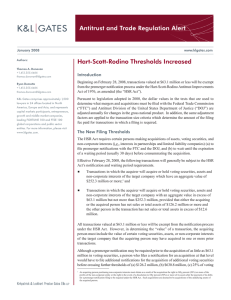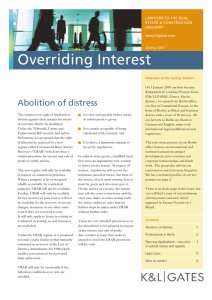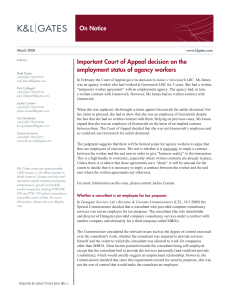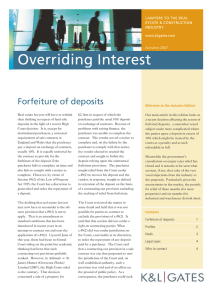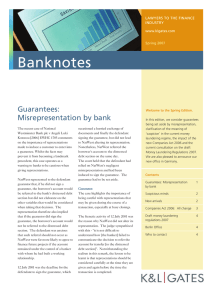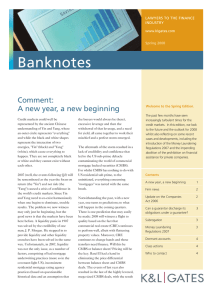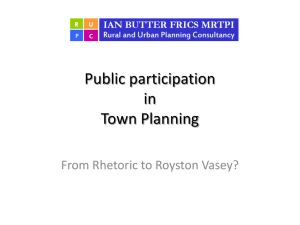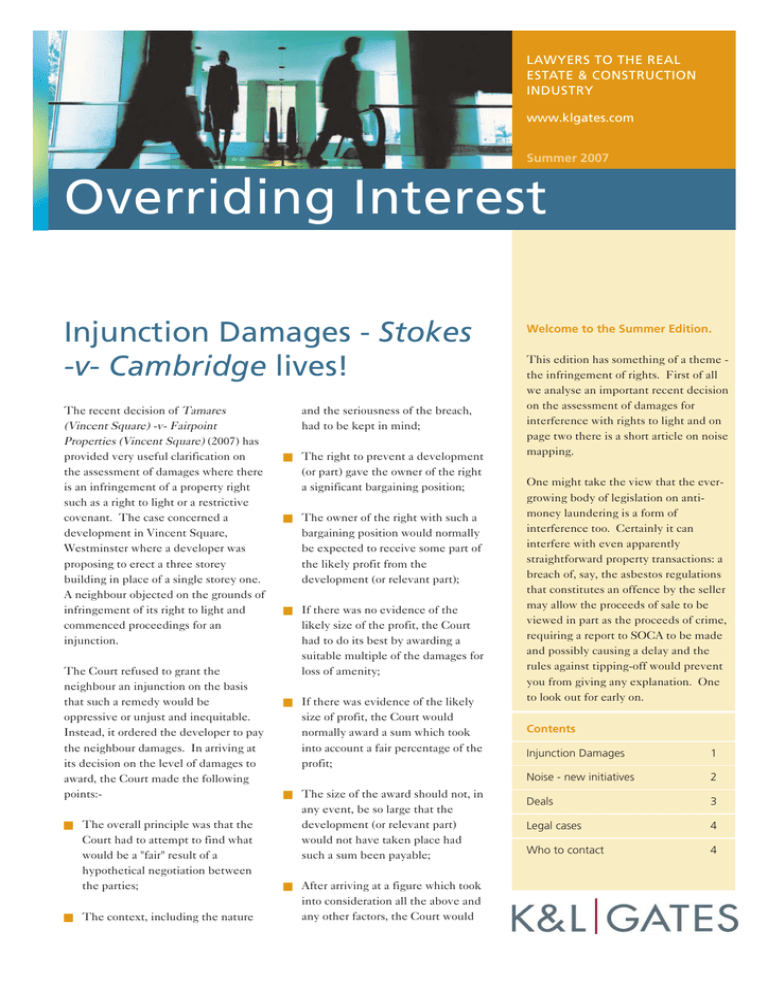
LAWYERS TO THE REAL
ESTATE & CONSTRUCTION
INDUSTRY
www.klgates.com
Summer 2007
Overriding Interest
Injunction Damages - Stokes
-v- Cambridge lives!
The recent decision of Tamares
(Vincent Square) -v- Fairpoint
Properties (Vincent Square) (2007) has
provided very useful clarification on
the assessment of damages where there
is an infringement of a property right
such as a right to light or a restrictive
covenant. The case concerned a
development in Vincent Square,
Westminster where a developer was
proposing to erect a three storey
building in place of a single storey one.
A neighbour objected on the grounds of
infringement of its right to light and
commenced proceedings for an
injunction.
The Court refused to grant the
neighbour an injunction on the basis
that such a remedy would be
oppressive or unjust and inequitable.
Instead, it ordered the developer to pay
the neighbour damages. In arriving at
its decision on the level of damages to
award, the Court made the following
points:
The overall principle was that the
Court had to attempt to find what
would be a "fair" result of a
hypothetical negotiation between
the parties;
The context, including the nature
and the seriousness of the breach,
had to be kept in mind;
The right to prevent a development
(or part) gave the owner of the right
a significant bargaining position;
The owner of the right with such a
bargaining position would normally
be expected to receive some part of
the likely profit from the
development (or relevant part);
If there was no evidence of the
likely size of the profit, the Court
had to do its best by awarding a
suitable multiple of the damages for
loss of amenity;
If there was evidence of the likely
size of profit, the Court would
normally award a sum which took
into account a fair percentage of the
profit;
The size of the award should not, in
any event, be so large that the
development (or relevant part)
would not have taken place had
such a sum been payable;
After arriving at a figure which took
into consideration all the above and
any other factors, the Court would
Welcome to the Summer Edition.
This edition has something of a theme the infringement of rights. First of all
we analyse an important recent decision
on the assessment of damages for
interference with rights to light and on
page two there is a short article on noise
mapping.
One might take the view that the evergrowing body of legislation on antimoney laundering is a form of
interference too. Certainly it can
interfere with even apparently
straightforward property transactions: a
breach of, say, the asbestos regulations
that constitutes an offence by the seller
may allow the proceeds of sale to be
viewed in part as the proceeds of crime,
requiring a report to SOCA to be made
and possibly causing a delay and the
rules against tipping-off would prevent
you from giving any explanation. One
to look out for early on.
Contents
Injunction Damages
1
Noise - new initiatives
2
Deals
3
Legal cases
4
Who to contact
4
Overriding Interest
consider whether the "deal felt
right".
In the Tamares case, there was
evidence of the likely size of profit that
the developer would make. The Court
took note of the approach of the Lands
Tribunal in the compulsory purchase
decision of Stokes -v- Cambridge
Corporation (1961) in which one-third
of the development value was awarded
as the cost of acquiring land to gain
access to backland with development
potential but without existing access.
The Court assessed the developer's
profit as being just under £175,000,
took one-third of that figure and then
rounded it down to £50,000 as being
the fair result. That award was
substantially above the loss of amenity
that the neighbour would suffer from
the development which the parties
agreed would not be in excess of
£3,000.
In a related development, in the case of
WWF Worldwide Fund for Nature -vWorld Wrestling Federation
Entertainment (2007), a case in which
K&L Gates acted, the Court made the
point that it is not necessary for there to
be a claim for an injunction in order for
it to adopt the "hypothetical
negotiation" approach to the
assessment of damages taken in the
Tamares case. The Court said it had
the general power to award damages on
that basis.
In the light of the Tamares and WWF
decisions - along with the well reported
case of Regan -v- Paul Properties
(2006), which showed that the Courts
are now likely to grant more readily
injunctions for infringement of
property rights, it is clear that in future,
developers will have to consider much
more carefully the rights and interests
of their neighbours and negotiate away
those rights. If developers simply
disregard those rights and develop in
infringement of them, the Court is
more likely to grant injunctions forcing
developers to respect those rights or
else penalise them substantially in
terms of large damages awards.
Noise - new initiatives
Over recent years the government has
responded in a number of ways to
increasing public concern about noise:
planning controls
limits at source for plant and
equipment, motor vehicles, aircraft
etc
excessive noise as a statutory
nuisance
street noise controls of
loudspeakers, construction sites,
intruder alarms and entertainment
events
To some extent the initiatives are
being drawn together as a consequence
of the EU Noise Directive 2002/49/EC,
the main aim of which is to provide a
common basis for tackling noise
problems throughout the Union. The
Directive effectively requires local
2
SUMMER 2007
authorities in member states to prepare
strategic noise maps for major roads,
railways, airports and conurbations.
Thereafter, member states will be
required to create action plans to
reduce noise and to maintain
acceptable levels. Implementation in
England started with the
Environmental Noise (England)
Regulations 2006 which set down the
structure for progress. Now the
Secretary of State has introduced the
Environmental Noise (Identification of
Noise Sources) (England) Regulations
2007 SI 2007 No 415. These
Regulations are in force from 19 March
2007 and impose a programme for
identification of "first round" noise
sources, including:
urban conurbations with more than
50,000 people and a population
density of 500 people per square
kilometre, or greater;
major roads with more than 3
million vehicle passengers a year
which will include most trunk
roads, motor ways and principal or
classified roads;
major railways;
major airports
All of these maps were required to be
in place by the end of June 2007. The
London Road Traffic Noise map is
already available on
www.noisemapping.org. These noise
maps are likely to be a useful source of
information for the property industry
and its advisors. Please contact the
Planning and Environment Group at
K&L Gates if you require further
assistance.
www.klgates.com
Deals
PRO Logis Park, Coventry
We advised CBRERT Coventry
Limited, a subsidiary of CB Richard
Ellis Realty Trust, on the
acquisition of 602 Central
Boulevard, Prologis Park, Coventry
from an institutional fund based in
the UK for £11.2 million. The
property is fully let to Capita
Business Services Limited. It is the
first purchase in Europe for this US
REIT, whose strategy is to invest
up to 30% of its assets in quality
properties in overseas markets
where it can take advantage of its
strategic relationships with
affiliates. Financing for the
acquisition was provided by The
Royal Bank of Scotland. Our team
advising CB Richard Ellis Realty
Trust was led by Real Estate
partner, Melanie Curtis. The loan
was handled by Finance partner,
Richard Hardwick.
Thames Gateway
Real Estate partner Richard Smith
acted for Ravenbourne in relation
various sales in the Thames
Gateway area, indicating the
positive effects of the London
Olympics in 2012 on the property
industry in this location.
Crawley
We acted for a private Irish investor
on the sale of Woolworths premises
in Crawley for a consideration of £9
million. Real Estate partner, Chris
Major assisted by Real Estate
associate Fiona McPhillips handled
the transaction.
Retail warehouse units in
Croydon and South Shields
Real Estate partner Chris Major and
Real Estate assistant Paul Alger
acted on the acquisition of retail
warehouse units by Windsor Life
Assurance Company Limited
(represented by Arlington Property
Investors) for a consideration of
£10.35 million.
SUMMER 2007
3
Overriding Interest
www.klgates.com
Legal cases
Insolvency
Mistake
Co-ownership
A company voluntary arrangement
(CVA) that sought to release some, but
not all, parent company guarantees in
respect of premises leased by an
insolvent subsidiary was held to be
unfairly prejudicial.
Where a condition attached to a break
clause was included in the draft of a
lease but omitted by mistake from the
executed version of the lease, it was held
that the lease be rectified to reflect the
draft.
Where a co-habiting couple bought a
property in their joint names but made
no declaration as to respective interests
in the property, it was held that the
starting point for the assessment of those
interests was an equal split.
Comment: A major decision that, if it
had been decided otherwise, would have
cost commercial landlords billions of
pounds in lost value.
Comment: The mistake had been
noticed but not corrected prior to
execution.
Comment: The person seeking a
different split had the onus of
establishing it.
KPMG -v- Network Rail Infrastructure,
CA
Stack -v- Dowden, HL
Prudential Assurance Co -v- PRG
Powerhouse, ChD
Chattels
Easements
Restrictive Covenants
It was held that the Lands Tribunal was
right to treat the existence of a building
scheme as relevant to its refusal to
modify a restrictive covenant which
prevented further development of land.
Comment: The tests set out in section
84 of the Law of Property Act 1925 were
not satisfied by the landowner.
A claim for an easement of necessity on
the severance of two plots of land failed
because, when the first plot was sold, the
landowner did not need a right of way
over that plot as, at the time of the
severance, there was a realistic possibility
of alternative access.
Comment: The landowner should have
reserved a specific right of access in
favour of the retained plot.
Dobbin -v- Redpath, CA
Adealon International Proprietary -vMerton LBC, CA
Who to Contact
For further information contact
Steven Cox
steven.cox@klgates.com
Milton McIntosh
milton.mcintosh@klgates.com T: +44 (0)20 7360 8259
T: +44 (0)20 7360 8213
The owner of a tenant company
provided paintings for leased premises
which, on the failure and liquidation of
the tenant, were removed by the
landlord who said he was waiting to hear
from the liquidator regarding returning
them. The landlord was found guilty of
conversion.
Comment: The landlord should have
established the position with the
liquidator within a reasonable period of
time.
Tavoulareas -v- Lau, CA
K&L Gates
110 Cannon Street
London EC4N 6AR
www.klgates.com
K&L Gates comprises approximately 1,400 lawyers in 22 offices located in North America, Europe and Asia, and represents capital markets participants, entrepreneurs, growth
and middle market companies, leading FORTUNE 100 and FTSE 100 global corporations and public sector entities. For more information, please visit www.klgates.com.
K&L Gates comprises multiple affiliated partnerships: a limited liability partnership with the full name Kirkpatrick & Lockhart Preston Gates Ellis LLP qualified in Delaware and
maintaining offices throughout the U.S., in Berlin, and in Beijing (Kirkpatrick & Lockhart Preston Gates Ellis LLP Beijing Representative Office); a limited liability partnership (also
named Kirkpatrick & Lockhart Preston Gates Ellis LLP) incorporated in England and maintaining our London office; a Taiwan general partnership (Kirkpatrick & Lockhart Preston
Gates Ellis) which practices from our Taipei office; and a Hong Kong general partnership (Kirkpatrick & Lockhart Preston Gates Ellis, Solicitors) which practices from our Hong
Kong office. K&L Gates maintains appropriate registrations in the jurisdictions in which its offices are located. A list of the partners in each entity is available for inspection at any
K&L Gates office.
This publication/newsletter is for informational purposes and does not contain or convey legal advice. The information herein should not be used or relied upon in regard to any
particular facts or circumstances without first consulting a lawyer.
Data Protection Act 1998 - We may contact you from time to time with information on Kirkpatrick & Lockhart Preston Gates Ellis LLP seminars and with our regular newsletters,
which may be of interest to you. We will not provide your details to any third parties. Please e-mail london@klgates.com if you would prefer not to receive this information.
4
SUMMER 2007
©1996-2007 Kirkpatrick & Lockhart Preston Gates Ellis LLP. All Rights Reserved.



